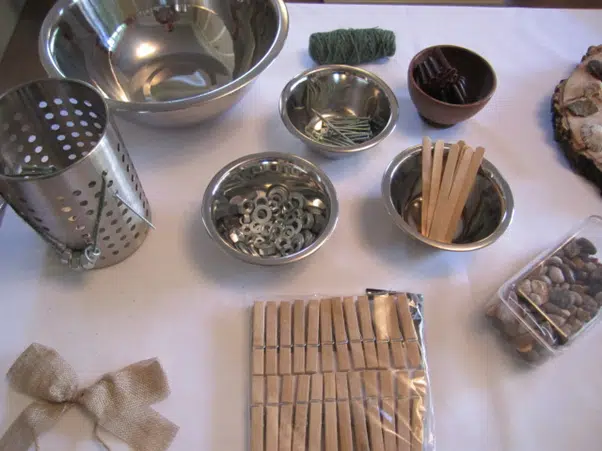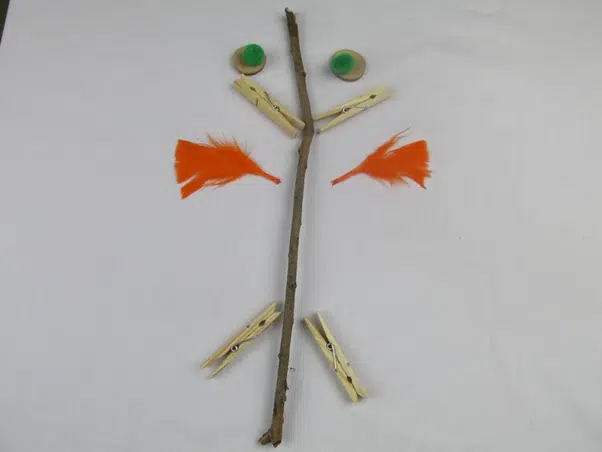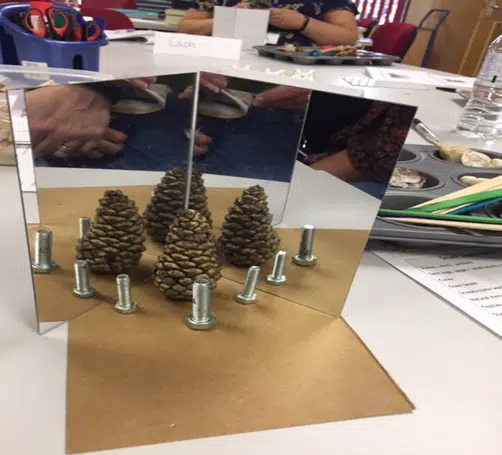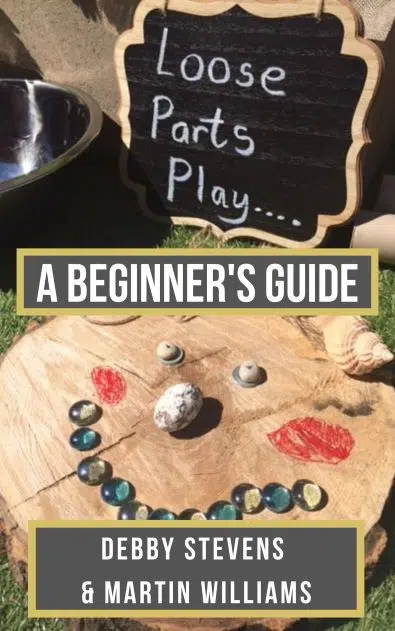There are many skills that are central to science that are fostered by children engaging in loose parts play. Some key ones include:
- Investigating
- Exploring
- Creating and testing hypotheses
- Constructing and deconstructing ideas
- Engaging with the world around them.
There are all sorts of experiments that children can try out using loose parts.
Many of these will be spontaneous and happen naturally through play. Some can be more structured, and you can find out a range of scientific information by using a few simple found objects.
Here are some excellent activities for investigating and understanding the world using loose parts play…

1.Floating/Sinking
Some loose parts will float and some will sink! It really is that simple.
Loose parts in water play will always lead to some level of floating and sinking understanding.
Some loose parts will act like boats, and can hold other things that would otherwise sink.
Children can explore weight, size, shape, and begin to develop an understanding of how these link to floating and sinking.
2.Exploring Gravity
Children love using things like ramps and slides.
They are great for rolling things down, such as conkers, wooden blocks, bottle tops, and many other items.
They start to understand the properties of things that roll and things that don’t.
They begin to predict about which objects will go faster downhill, and which slower.
They also explore how some things fall differently when you drop them, for example a feather.
Exploring is one of the central skills developed by loose parts play. To find out all the benefits of loose parts play then check this article out.
3.Explore Shadows Using Loose Parts
This is a great way of getting children thinking about shadows and the movement of the sun.
You simply get some big loose parts and place them somewhere in the sun where they will not get moved by mistake. Something like a gutter, a box, or a log would be good.
On a big piece of paper is a good place to put them, or on the floor in a corner. You may want to cone them off, so no-one touches them by mistake!
Near the start of the day, get the children to look at what shadows the objects are making on the floor. They can draw round the shadows with pens or chalk.
Then come back out in the afternoon. Where are the shadows now?
Draw them on with a different colour.
This activity is one of the 40 best loose parts play activities that you can cread in this article here.
4.Explore Light Using An OHP
Overhead Projectors are very much alive and well in modern early years education.
They are a great way of exploring light with a range of random objects.
Children can use loose parts to create pictures, patterns and arrays. They can place these onto the projector and investigate the effect that is produced on the wall.
They can experience first-hand the darkness of the shadows, and the light of the gaps in between.
5.Explore Anatomy By Building People Models
Loose parts are an excellent tool for making big transient art pictures of people on the floor.
Children can explore the different features that our bodies have.
What do faces contain?
What are the proportions of our limbs?
How many fingers and toes do we have?
There are so many questions they can begin to answer.

6.Catogerising Objects
Loose parts can be sorted into different groups. This could be based on many different reasons. For example, loose parts could be sorted into:
- Metal v wood
- Hard v soft
- Heavy v light
- Roll v doesn’t roll
- Can be stacked v can’t be
7.Exploring Properties Of Materials
In using loose parts, children explore their different properties first-hand.
For example, they think about which materials are best for representing something else. String looks like hair, for example.
Planks are strong enough to stand on, but sticks are not.
Conkers cannot be built into a tower, but wood slices can.
Children experience success and failure in testing out different materials for their projects, and they learn to understand the objects more deeply.
8.Creating Dark Dens
Children love using assorted materials and sheets to create spaces that are enclosed, and where little light can get in.
This is great for experiencing darkness and its features.
9.Problem Solving With Gutters/Ramps
Large scale loose parts constructing outdoors is excellent for problem solving and scientific enquiry. Outdoors is one of the best settings for open-ended play, and you can read my essential guide to outdoor loose parts play here.
Children can use gutters and planks to create walkways and pathways for objects to roll down.
They can create runways for water or balls.
They experiment with gravity, and how things roll or flow.
10.Punk Cogs
There are some random items you can include in loose parts play that can have multiple purposes and are just really fiddly to pick up.
One of these is punk cogs.
These mysterious, alluring items are great for building with and creating transitional art. They really require good fine motor to pick up and manipulate.
11.Manipulating Beans, Beads And Similar
There are all sorts of tiny loose parts that you can use in a range of ways.
Some examples include:
- Beans
- Beads
- Tiny jewels
- Small pompoms
- Lentils
- Chick-peas
These can be combined with a range of containers, tweezers, tongs, and all sorts of other things to help manipulate them.
There are so many items you can find that are great for loose parts play! To find out up to 100 ideas check out this list of materials you’ve got to try.
12.Using Sliced Fruit
This is another beautiful multi-sensory resource.
Great choices of fruit to slice includes things such as grapefruit, lemon, oranges, and limes. They create a fantastic array of sight, smell and texture.
You can use them for transitional art, construction, making portraits, or potion-making.
- What are some examples of risky play? Fine out 25 ideas
- What are the main benefits of risky play? 21 Ideas
13.Symmetry In Mirror Books
These mirror books are a brilliant activity, and really cross-curricular. This is one of many activities in my article all about 14 symmetry activities for kids.
You get two perspex safety mirrors and tape them together to form a ninety degree angle.
Then you place different objects within the two mirrors. All sorts of reflective effects are achieved. They are particularly good for beginning a very basic understanding of:
- Doubling
- Multiplication
- Counting
- Arrays

14.Painting With Loose Parts
This is an excellent, and cross-curricular activity, involving both artistic enquiry and scientific investigation of different materials and their textures.
Many small objects can be used as a mini paint brush. You will get different effects with different objects.
For example, painting with a pom pom will get a really wide line.
Painting with a screw will get a really thin line.
Feathers will make a wispy pattern, sticks a simple clear line.
15.Exploring Different Sounds With Loose Parts
You can use different objects placed in bottles to create musical shakers. These will all have a unique sound based on the property of the object.
For example, a jar of bolts would be really loud and tinkly.
A jar of wood slices would create a quieter, duller sound.
These are all fantastic for early phonics and discriminating sounds.
16.Building With Loose Parts
This can be done either indoors in a smaller scale, or using large loose parts in the outdoors.
Children can stack, build towers, and create whatever they like.
Some excellent materials for this indoors include:
- Wood slices
- Pegs
- Lolly sticks
- Logs
- Sticks
- Stones
Outdoors, some good materials would include:
- Crates
- Tubes
- Gutters
- Planks
- Tyres
- Pallets
Conclusion
Loose parts and science just naturally goes brilliantly together. It is great to see children investigating and wanting to find out things, and often this will be happening spontaneously without any adult prompting.
If you are reading this and live in the UK, you might want to check out our Loose Parts Play practical training course that we run at venues throughout England and Wales. Here is a link to a description of that course.
This article is an extract from the book ‘Loose Parts Play – A Beginner’s Guide’ written by myself and my colleague Debby Stevens. This book provides a full, yet simple guide to setting up an outstanding loose parts culture in your home or educational setting with children aged 0-5. To check out the book on Amazon, then follow this link

